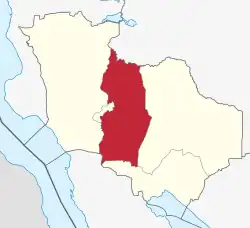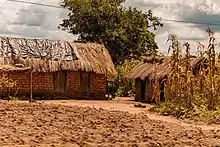Nsimbo District
Nsimbo District is a district council in the Katavi Region of Tanzania's Southern Highlands established in 2012. The district lies in the middle of the region east of the city of Mpanda. It is a tropical environment of mostly forest reserves and agricultural economy.
Nsimbo | |
|---|---|
 | |
 Nsimbo District location in the Katavi Region | |
| Coordinates: 6.3727°S 31.184°E | |
| Country | |
| Region | Katavi Region |
| District | Nsimbo District |
| Established[1] | 2012 |
| Government | |
| • Type | Council |
| • Chairman[2] | Halawa Charles Malendeja |
| • Director[2] | Mohamed Ramadhani |
| Area [3]: 1 | |
| • Total | 14,623 km2 (5,646 sq mi) |
| • Water | 292.46 km2 (112.92 sq mi) |
| Highest elevation | 2,500 m (8,200 ft) |
| Lowest elevation | 1,000 m (3,000 ft) |
| Population | |
| • Total | 157,633 |
| • Density | 11/km2 (28/sq mi) |
| Time zone | UTC+3 (EAT) |
| Postcode[5] | 50xxx |
| Area code | 025 |
| Website | District Website |
History
Originally, Nsimbo was a part of both the Tabora Region and Mbeya Regions. In 1973, the Rukwa Regional Council was created from parts of those two regions, and in 1983 the Mpanda District Council was created within Rukwa.[6][7] In 1990 the town of Mpanda split off from the district council to create a separate town council.[8]
In 2012, The Katavi Region split off from the Rukwa Region, with the 4 districts of Mpanda District, Mpanda Town, and a new district councils of Mlele District and Nsimbo District.[9] In 2015 the Mpanda Town Council was promoted to a municipal council, and in 2016 the portions of Mlele to the south of Nsimbo would be split off to form the Mpimbwe District Council.[10][11]: 1
Geography
The Nsimbo District lies in the middle of the Katavi Region east of the city of Mpanda. The Katavi districts of Mpanda District and Mpanda Municipality lie to the west, Mlele District is to the east, and Mpimbwe District is south of Nsimbo. North is the Kaliua District of the Tabora Region, and south-west is the Nkasi District of the Rukwa Region.[12][1]
The district covers an area of 14,623 square kilometres (5,646 sq mi). Most of the district is protected forest reserve with 8,920.03 km2 (3,444.04 sq mi) of protected forest. The elevation varies between 1,000 m (3,300 ft) to 2,500 m (8,200 ft). Within the district is much of the Katavi National Park and Ugalla River Forest Reserve which overlaps with the Ugalla River National Park into the Tabora Region.[11]: 1-2 [13][14]
Climate
The districts climate is tropical savanna climate with the Aw Koppen-Geiger system classification. The average temperature is 23 °C (73 °F) with an average rainfall of 1,093 millimetres (43.0 in).[15]
Administrative divisions
Mpimbwe has two division, 12 wards, and 59 villages and 272 hamlets.[16][3]: 1
Wards (2016 population)[4]: 174
- Ibindi (6,046)
- Itenka (18,348)
- Kanoge (17,954)
- Kapalala (5,130)
- Katumba (27,239)
- Litapunga (35,444)
- Machimboni (4,621)
- Mtapenda (5,475)
- Nsimbo (8,085)
- Sitalike (10,969)
- Ugalla (11,352)
- Urwila (6,970)
Demographics

In 2016 the Tanzania National Bureau of Statistics report there were 157,633 people in the district, from 144,245 in 2012. Wabende, Wakonongo, Wafipa, Wapimbwe, Bahutu, Wachanga, and Basukuma make up the people.[4]: 174 [3]: 2
Economy
The economy is primarily agriculture. Food crops grown are cassava, maize, paddy, sweet potatoes, round potatoes, bananas, yams, and other fruits and vegetables. Crops grown for money are tobacco, peanuts, sunflowers, sesame, and sugarcane.[17]
There are no large or medium scale industries or mining operations in the district, but locals do small scale mining of gold, copper, silver, lead, tungsten, rose quarts, and nitre.[18]
Health and education
Nsimbo has 3 health centers, and 18 health clinics. There are 47 primary schools, and 8 secondary schools in the district.[16]
References
- "Historia". nsimbodc.go.tz (in Swahili). Nsimbo: Nsimbo District Council. Archived from the original on 12 September 2022. Retrieved 12 September 2022.
- "Halmashauri ya Wilaya ya Nsimbo". nsimbodc.go.tz (in Swahili). Nsimbo: Nsimbo District Council. Archived from the original on 12 September 2022. Retrieved 12 September 2022.
- "Nsimbo DC Strategic Plan" (PDF). nsimbodc.go.tz. Nsimbo: Nsimbo District. July 2015. Archived (PDF) from the original on 17 June 2022. Retrieved 12 September 2022.
- 2016 Makadirio ya Idadi ya Watu katika Majimbo ya Uchaguzi kwa Mwaka 2016, Tanzania Bara [Population Estimates in Administrative Areas for the Year 2016, Mainland Tanzania] (PDF) (Report) (in Swahili). Dar es Salaam, Tanzania: National Bureau of Statistics. 1 April 2016. Archived (PDF) from the original on 27 December 2021. Retrieved 11 September 2022.
- "Katavi Postcodes" (PDF). Tanzania Communications Regulatory Authority. Archived (PDF) from the original on 29 July 2022. Retrieved 11 September 2022.
- "Historia". rukwa.go.tz (in Swahili). Rukwa: Rukwa Regional Council. Archived from the original on 15 June 2022. Retrieved 11 September 2022.
- "Historia". mpandadc.go.tz (in Swahili). Mpanda: Mpanda District Council]. Archived from the original on 15 June 2022. Retrieved 12 September 2022.
- "Historia". mpandamc.go.tz (in Swahili). Mpanda: Mpanda. Archived from the original on 5 April 2022. Retrieved 12 September 2022.
- "Historia". katavi.go.tz (in Swahili). Mpanda: Katavi District Council]. Archived from the original on 16 June 2022. Retrieved 12 September 2022.
- "Mpango Mkakati". mleledc.go.tz (in Swahili). Mlele: Mlele District Council. Archived from the original on 18 June 2022. Retrieved 11 September 2022.
- Kiwale, Erasto N. (June 2016). "Mpimbwe District Council Strategic Plan" (PDF). mpimbwedc.go.tz. Mpimbwe District: Mpimbew District Council. Archived (PDF) from the original on 27 June 2022. Retrieved 11 September 2022.
- "Tanzania Districts Shapefiles - 2019". nbs.go.tz (in English and Swahili). Dodoma, Tanzania: National Bureau of Statistics (Tanzania). Archived from the original on 9 September 2022. Retrieved 11 September 2022.
- "Katavi National Park". tanzaniaparks.go.tz (in English and Swahili). Dodoma, Tanzania: Tanzania National Parks Authority. Archived from the original on 7 July 2022. Retrieved 11 September 2022.
- "Ugalla River Forest Reserve, Katavi Region, Tanzania". mindat.org. Archived from the original on 12 September 2022. Retrieved 12 September 2022.
- "Climate Uruwira (Tanzania)". climate-data.org (in English and German). Germany: Climate-data. Archived from the original on 12 September 2022. Retrieved 12 September 2022.
- "Takwimu". nsimbodc.go.tz (in Swahili). Nsimbo: Nsimbo District Council. Archived from the original on 17 June 2022. Retrieved 12 September 2022.
- "Kilimo". nsimbodc.go.tz (in Swahili). Nsimbo: Nsimbo District Council. Archived from the original on 12 September 2022. Retrieved 12 September 2022.
- "Uchimbaji Madini". nsimbodc.go.tz (in Swahili). Nsimbo: Nsimbo District Council. Archived from the original on 12 September 2022. Retrieved 12 September 2022.